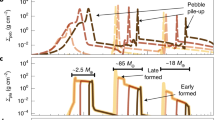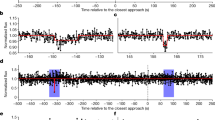Abstract
Most planetary rings in the Solar System lie within a few radii of their host body, because at these distances gravitational accelerations inhibit satellite formation. The best known exceptions are Jupiter’s gossamer rings1 and Saturn’s E ring, broad sheets of dust that extend outward until they fade from view at five to ten planetary radii. Source satellites continuously supply the dust, which is subsequently lost in collisions or by radial transport. Here we report that Saturn has an enormous ring associated with its outer moon Phoebe, extending from at least 128RS to 207RS (Saturn’s radius RS is 60,330 km). The ring’s vertical thickness of 40RS matches the range of vertical motion of Phoebe along its orbit. Dynamical considerations argue that these ring particles span the Saturnian system from the main rings to the edges of interplanetary space. The ring’s normal optical depth of ∼2 × 10-8 is comparable to that of Jupiter’s faintest gossamer ring, although its particle number density is several hundred times smaller. Repeated impacts on Phoebe, from both interplanetary and circumplanetary particle populations, probably keep the ring populated with material. Ring particles smaller than centimetres in size slowly migrate inward2,3 and many of them ultimately strike the dark leading face of Iapetus.
This is a preview of subscription content, access via your institution
Access options
Subscribe to this journal
Receive 51 print issues and online access
$199.00 per year
only $3.90 per issue
Buy this article
- Purchase on Springer Link
- Instant access to full article PDF
Prices may be subject to local taxes which are calculated during checkout




Similar content being viewed by others
References
Burns, J. A. et al. The formation of Jupiter’s faint rings. Science 284, 1146–1150 (1999)
Soter, S. Remarks on origin of Iapetus’ photometric asymmetry. IAU Colloq. 28, abstract (1974)
Burns, J. A., Hamilton, D. P., Mignard, F. & Soter, S. The contamination of Iapetus by Phoebe dust. Astron. Soc. Pacif. Conf. Ser. 104B, 179–182 (1996)
Porco, C. C. et al. Cassini imaging science: initial results on Phoebe and Iapetus. Science 307, 1237–1242 (2005)
Hamilton, D. P. Motion of dust in a planetary magnetosphere–orbit-averaged equations for oblateness, electromagnetic, and radiation forces with application to Saturn’s E ring. Icarus 101, 244–264 (1993)
Cruikshank, D. P. et al. The dark side of Iapetus. Icarus 53, 90–104 (1983)
Buratti, B. J. & Mosher, J. A. The dark side of Iapetus: additional evidence for an exogenous origin. Icarus 115, 219–227 (1995)
Vilas, F., Larsen, S. M., Stockstill, K. R. & Gaffey, M. J. Unraveling the zebra: clues to the Iapetus dark material composition. Icarus 124, 262–267 (1996)
Jarvis, K. S., Vilas, F., Larsen, S. M. & Gaffey, M. J. Are Hyperion and Phoebe linked to Iapetus? Icarus 146, 125–132 (2000)
Buratti, B. J., Hicks, M. D., Tryka, K. A., Sittig, M. S. & Newburn, R. L. High resolution 0.33–0.92 μm spectra of Iapetus, Hyperion, Phoebe, Rhea, Dione, and D-type asteroids: How are they related? Icarus 155, 375–381 (2002)
Buratti, B. J., Hicks, M. D. & Davies, A. Spectrophotometry of the small satellites of Saturn and their relationship to Iapetus, Phoebe, and Hyperion. Icarus 175, 490–495 (2005)
Cruikshank, D. P. et al. Hydrocarbons on Saturn’s satellites Iapetus and Phoebe. Icarus 193, 334–343 (2008)
Clark, R. N. et al. Compositional mapping of Saturn’s moon Phoebe with imaging spectroscopy. Nature 435, 66–69 (2005)
Nesvorný, D. Alvarellos, J. L. A., Dones, L. & Levison, H. F. Orbital and collisional evolution of the irregular satellites. Astron. J. 126, 398–429 (2003)
Hamilton, D. P. &. Krüger, H. The sculpting of Jupiter’s gossamer rings by its shadow. Nature 453, 72–75 (2008)
Hamilton, D. P. The asymmetric time-variable rings of Mars. Icarus 119, 153–172 (1996)
Acknowledgements
This work is based on observations made with the Spitzer Space Telescope, which is operated by the Jet Propulsion Laboratory, California Institute of Technology under a contract with NASA. Support for this work was provided by NASA through an award issued by JPL/Caltech.
Author Contributions All authors contributed substantially to this work. A.J.V. and M.F.S. did most of the observation planning, data reduction, and associated write-up. D.P.H. contributed most of the dynamical interpretations and write-up.
Author information
Authors and Affiliations
Corresponding author
Supplementary information
Supplementary Information
This file contains Observational Details and Results and a Supplementary Figure. (PDF 602 kb)
Rights and permissions
About this article
Cite this article
Verbiscer, A., Skrutskie, M. & Hamilton, D. Saturn's largest ring. Nature 461, 1098–1100 (2009). https://doi.org/10.1038/nature08515
Received:
Accepted:
Published:
Issue Date:
DOI: https://doi.org/10.1038/nature08515
This article is cited by
-
Spitzer’s Solar System studies of asteroids, planets and the zodiacal cloud
Nature Astronomy (2020)
-
A new moon for Neptune
Nature (2019)
-
Circumplanetary Dust Populations
Space Science Reviews (2019)
-
Dust Emission by Active Moons
Space Science Reviews (2018)
-
Dust Phenomena Relating to Airless Bodies
Space Science Reviews (2018)
Comments
By submitting a comment you agree to abide by our Terms and Community Guidelines. If you find something abusive or that does not comply with our terms or guidelines please flag it as inappropriate.



